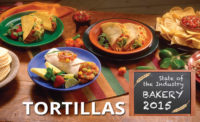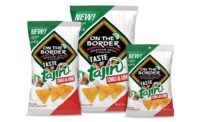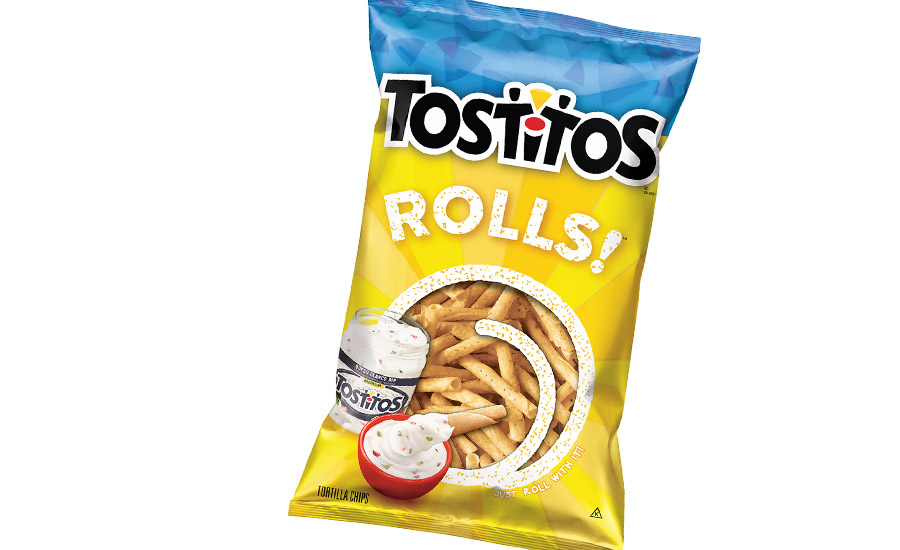Tortilla Chips - New Flavors: State of the Industry 2015


courtesy of Snyder’s-Lance

courtesy of Snyder’s-Lance

courtesy of RW Garcia

courtesy of Wire Belt Company of America

courtesy of Frito-Lay North America

courtesy of The Hain Celestial Group













Not too long ago, most Americans solely associated tortilla chips with Mexican restaurants. Today, tortilla chips continue to show up at snack occasions previously dominated by potato chips, pretzels, popcorn and crackers.
Overview | Chips | Puffed/Extruded Snacks | Popcorn | Snack Mixes & Nuts | Tortilla Chips | Pretzels | Frozen Snacks | Crackers
And why not? Unlike many salty-snack rivals, tortilla chips are available in a variety of versatile shapes that can stand up to dips, salsas and other toppings, as well as carry on-trend flavors. They’re also typically gluten-free—an important factor for consumers with celiac disease and other dietary concerns or preferences—and are often made with organic, non-GMO and other better-for-you ingredients.
Market data
According to IRI, Chicago, tortilla/tostada chips came in second in the salty snacks category for the 52 weeks ending May 17, 2015, with sales of $4.74 billion, an increase of 3.54 percent from the previous year. Their American cousins—potato chips—retained their No. 1 spot with $7.23 billion in sales.
Not surprisingly, Frito-Lay North America dominated the tortilla/tostada chips category, with $3.51 billion in sales for the 52-week period, a 2.95 percent increase from the previous year. Several of its brands—Doritos ($1.92 billion), Tostitos ($631.51 million), Tostitos Scoops! ($453.60 million) and Santitas ($255.44 million)—were the top-sellers in the category.
Private label tortilla/tostada chips came in a distance fifth, with sales of $219.44 million for the year.
Looking back
“In general, people are snacking more,” says David Tessier marketing research analyst, Wire Belt Company of America, Londonderry, NH. “The snack food industry continues to experience growth. For tortilla chip producers, this means coming up with new and innovative products that are competitive against other snack options. Some new popular offerings include rolled, restaurant-style and flavored tortilla chips.”
Frito-Lay launched Tostitos Rolls! in December. They join their spicier cousins, Doritos Dinamita rolled tortilla chips, which were introduced in spring 2012.
“We’re really expanding our rolled tortilla offerings,” says Joe Papiri, vice president of sales and marketing, Snak King, City of Industry, CA. “We see this as a new, unique way to deliver flavor or create a new way to accompany dips.” The company’s El Sabroso brand Taco-Litos are available in Salsa Picante, Guacamole and Chile N’ Lime.
Sales of Barcel USA’s Takis Fuego rolled tortilla chips were up 3.56 percent—to $142.94 million—for the 52-week period. The chips are also available in Fajita, Guacamole, Nitro, Salsa Brava and Xplosion. Barcel is a division of Grupo Bimbo.
Scoop-shaped tortilla chips continue to entice consumers. In February, Snyder’s-Lance Inc. launched Sea Salt & Lime Dipping Chips under its Eatsmart Snacks brand and Tortilla Dipping Shells under its Cape Cod brand. The latter are available in Four Bean (black, pinto, red and adzuki), Blue Corn Multigrain (blue corn, chia seeds and brown rice) and Ancient Grain (quinoa, black sesame and amaranth).
Introduced several years ago, Frito-Lay’s Tostitos Scoops! saw sales of $453.61 million for the year, up 3.66 percent. They come in Original, Multigrain and Fajita.
Tortilla strips also facilitate dipping. “Dippers offer a unique shape and texture,” says Genelle Chetcuti, director of marketing, RW Garcia Co. Inc., San Jose, CA. She notes that the company’s dippers, available in varieties like Veggie, Blue Corn and Sweet Potato, have been very popular with consumers. (Read more about RW Garcia in the April 2015 issue of Snack Food & Wholesale Bakery and online at www.snackandbakery.com.)
Perhaps the most innovative tortilla snack format to hit retail shelves this year was Doritos Jacked 3D tortilla snacks. Available in Jalapeño Pepper Jack, the 3-D triangles offer a unique crunch experience.
Sam Garfinkel, senior brand manager, snacks, Garden of Eatin’, Hain Celestial Group, Lake Success, NY, notes that rolled tortillas and dippers help solidify the tortilla chip as a versatile base for salsa, guacamole and dips, and make tortilla snacks more user-friendly.
But despite the proliferation of different tortilla chip formats, the traditional restaurant-style triangle isn’t disappearing. It is, however, being joined by a thinner, crispier and flakier version called a cantina-style tortilla chip.
Garden of Eatin’ launched organic, non-GMO Cantina Style Tortilla Chips in two flavors in March: Blue Chips with Sea Salt and White Chips with Lime. “We’re trying to deliver kind of a hand-crafted experience in tortilla chips to the consumer,” says Garfinkel. “There are a lot of components that go into that—some of them in terms of the processes we use to get that thinner, more-homemade feel, and some that go into delivering that experience to consumers.”
The latter can include the language used to describe a product—like “restaurant-style” or “cantina-style”—as well as its packaging format. “You’ll see a lot of these types of products in a stand-up bag—a paper-style bag or one using graphics that look and feel kind of like paper,” explains Garfinkel. “It’s all in an effort to deliver a well-rounded experience to consumers—so they feel like they’re getting something new and different and almost homemade and true to the name ‘cantina-style.’”
Other brands currently offering cantina-style chips include Tostitos (Cantina Thin & Crispy Tortilla Chips and Cantina Traditional) and Shearer’s (Cantina Style Tortilla Chips).
Whether they’re making triangles, rounds, scoops or strips, tortilla chip manufacturers want to be sure that their products get to consumers in good shape. According to Tessier, part of this dials down to the conveyor belts a manufacturer uses.
Like potato chips, the tortilla chip category has seen an explosion of new and interesting flavors and ingredients.
“We see that flavor and taste really drive consumers to purchase, and creating unique flavor profiles is something that we specialize in,” says Chetcuti. “While we still create authentic tortilla chips, we like to be creative and develop flavors outside of what’s expected.” The company offers tortilla chips in flavors like Salsa, English Cheddar and Curry Mango.
Papiri notes that Snak King has always successfully marketed a guacamole-flavored tortilla chip under its El Sabroso brand called Guacachip. It’s El Sabroso Salsitas—salsa-based tortilla rounds—also do very well, he adds, as do El Sabroso Baja Limon Tortilla Chips, which have a strong citrus pop mixed with heat.
Frito-Lay’s Doritos brand introduced American consumers to Roulette Tortilla Chips this spring. Each bag contains mostly Doritos Nacho Cheese-flavored chips, with an occasional ultra-spicy chip. Because all the chips look similar, consumers don’t know whether the next chip they bite into is spicy-hot or not.
Not too many years ago, white corn was the new kid on the tortilla chip block. Now, tortilla chips made with blue corn, vegetables, ancient grains and other ingredients are vying for retail shelf space, as consumers look for healthier snack options.
“Better-for-you has driven innovation in the tortilla chip industry, which has responded by introducing exciting iterations of products by incorporating ancient grains, blue corn or nontraditional starches like potato and rice,” says Tessier. “These new product innovations have captured consumers’ interest and expanded the definition of a tortilla chip beyond a corn or flour product.”
Papiri notes that Snak King does “extremely well” with both white and blue tortilla chips, especially organic. The company recently began adding vegetables like spinach and kale to its tortilla chips.
“Vegetable-based snacks are taking off right now,” says Chetcuti. The company’s three MixtBag products—Yellow & Blue Corn, Red & Yellow, and Salsa—combine different flavors of tortilla chips in one bag. Its new Veggie MixtBag features three types of chips made with stone-ground corn: Spinach & Garlic; Carrot, Tomato & Sesame; and Red Beet & Onion. They contain no trans fats and are certified gluten-free.
Corn-based snacks are a natural fit for the growing gluten-free market. “We certify all of our products as gluten-free to ensure that those who follow a gluten-free diet can snack with confidence,” says Chetcuti.
Looking forward
As with other salty snacks, there’s plenty of competition in the tortilla chips category. “The tortilla chip category is crowded,” says Chetcuti. So chip producers need to help products stand out via quality, ingredient selection, branding, and innovation in flavors and formats.
Garfinkel notes that a lot of small players are entering the market with innovative products. “For us, a little bit of competition isn’t always a bad thing,” he acknowledges. “It forces us to continue to drive innovation and keeps us on our toes. It also gets our category in front of consumers, so it’s not always a bad thing. But, certainly, it is something that we see and recognize.”
The tortilla chip category is still the No. 1 natural, organic snack segment, says Garfinkel. “I see no reason for that to change. When you talk to consumers, their passion for the category is so clear. It’s not just a snack—it’s something that cues a whole bunch of emotional feelings. It’s closely tied to parties and football tailgating and things like that. Because of the space we occupy in consumers’ minds, and the space that we occupy within the broader salty snacks category, I think we’ll see continued growth in this area, and all the trends and consumer research that we’ve done supports that.”
Overview | Chips | Puffed/Extruded Snacks | Popcorn | Snack Mixes & Nuts | Tortilla Chips | Pretzels | Frozen Snacks | Crackers
Looking for a reprint of this article?
From high-res PDFs to custom plaques, order your copy today!
















